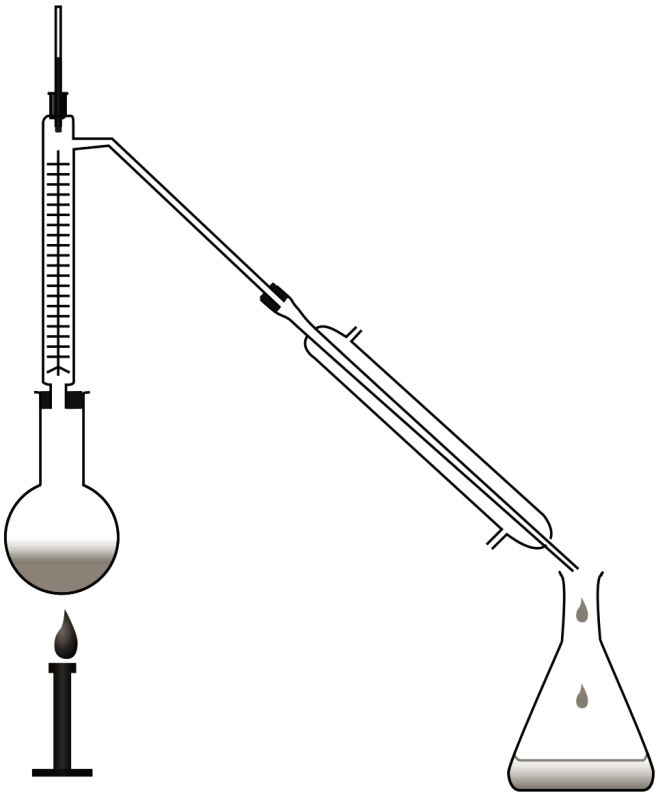
What is meant by fractional distillation? How does it differ from simple distillation? What part of the fractional distillation apparatus makes it more efficient and possesses an advantage over simple distillation processes? Explain using a diagram.
Give one example of fractional distillation in industry.
Answer
496.8k+ views
Hint: there are various techniques used for the separation of organic compounds. Distillation is a technique used to separate a mixture of organic compounds. Fractional distillation is a more efficient technique to separate various organic mixtures. It uses a fractional column that differs from simple distillation.
Complete answer:
There are methods applied to separate the mixtures of various organic solutions that are volatile or non – volatile. A method that is used to separate mixtures of volatile solutions having less difference in boiling points is fractional distillation. This consists of a fractionating column. The vapors of the liquid with less boiling point are vaporized first and then by successive vaporization and condensation the mixtures get separated.
Fractional distillation is different from simple distillation as simple distillation is suitable for separating volatile liquids from non – volatile solvents as they have sufficient difference in their boiling points, also the apparatus does not use a fractionating column.
Fractional distillation is more efficient from simple distillation as it possess a fractionating column on the mouth of the flask. This column has beads and is capable for successive condensation and vaporization called as theoretical plates in the fractionating column. This provides a more surface area for cooling and efficiency in separating solutions according to their boiling point differences. The diagram of a fractional distillation apparatus is:

An example of fractional distillation used in the industry is the distillation of crude oil in the petroleum industry.
Note:
There are some other distillation techniques apart from simple and fractional distillation like distillation under reduced pressure that is used to purify liquids having very high boiling points or for liquids that decompose below their boiling point, and steam distillation used to purify liquids that are steam volatile.
Complete answer:
There are methods applied to separate the mixtures of various organic solutions that are volatile or non – volatile. A method that is used to separate mixtures of volatile solutions having less difference in boiling points is fractional distillation. This consists of a fractionating column. The vapors of the liquid with less boiling point are vaporized first and then by successive vaporization and condensation the mixtures get separated.
Fractional distillation is different from simple distillation as simple distillation is suitable for separating volatile liquids from non – volatile solvents as they have sufficient difference in their boiling points, also the apparatus does not use a fractionating column.
Fractional distillation is more efficient from simple distillation as it possess a fractionating column on the mouth of the flask. This column has beads and is capable for successive condensation and vaporization called as theoretical plates in the fractionating column. This provides a more surface area for cooling and efficiency in separating solutions according to their boiling point differences. The diagram of a fractional distillation apparatus is:

An example of fractional distillation used in the industry is the distillation of crude oil in the petroleum industry.
Note:
There are some other distillation techniques apart from simple and fractional distillation like distillation under reduced pressure that is used to purify liquids having very high boiling points or for liquids that decompose below their boiling point, and steam distillation used to purify liquids that are steam volatile.
Recently Updated Pages
Master Class 11 Social Science: Engaging Questions & Answers for Success

Master Class 11 Physics: Engaging Questions & Answers for Success

Master Class 11 Maths: Engaging Questions & Answers for Success

Master Class 11 Economics: Engaging Questions & Answers for Success

Master Class 11 Computer Science: Engaging Questions & Answers for Success

Master Class 11 Chemistry: Engaging Questions & Answers for Success

Trending doubts
What is meant by exothermic and endothermic reactions class 11 chemistry CBSE

10 examples of friction in our daily life

Difference Between Prokaryotic Cells and Eukaryotic Cells

1 Quintal is equal to a 110 kg b 10 kg c 100kg d 1000 class 11 physics CBSE

One Metric ton is equal to kg A 10000 B 1000 C 100 class 11 physics CBSE

Draw a diagram of nephron and explain its structur class 11 biology CBSE




